Motorbiking through Vietnam has been, without a doubt, one of the best experiences in my life. It’s not easy, and is probably not for everyone, but if you’re at all interested — it is absolutely incredible! You will experience the land, the people, the elements, etc. in a way most travelers won’t get to — and I think you’ll understand the Vietnamese culture and daily life better because of it.
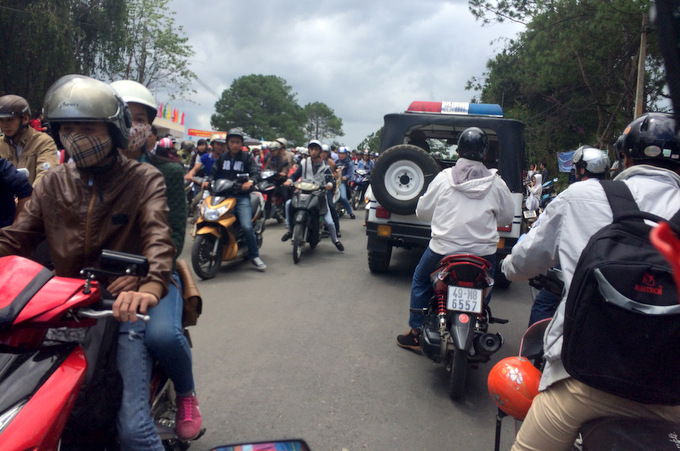
TRAFFIC! In Dalat.
This post is about our experiencing motorbiking through Vietnam, written with hopes of helping future motorbikers! We’ve been talking about coming to Vietnam for years, and finally started making plans to do it when we got engaged two and half years ago. Initially, we talked about motorbiking throughout the entire country — it seemed like a fun and adventurous way to see the land! We let that idea slide, as we talked to more and more people who told us we’d be killed within two seconds of driving in Hanoi. We arrived in Hanoi and agreed that motorbiking there was probably a task we weren’t ready to tackle.
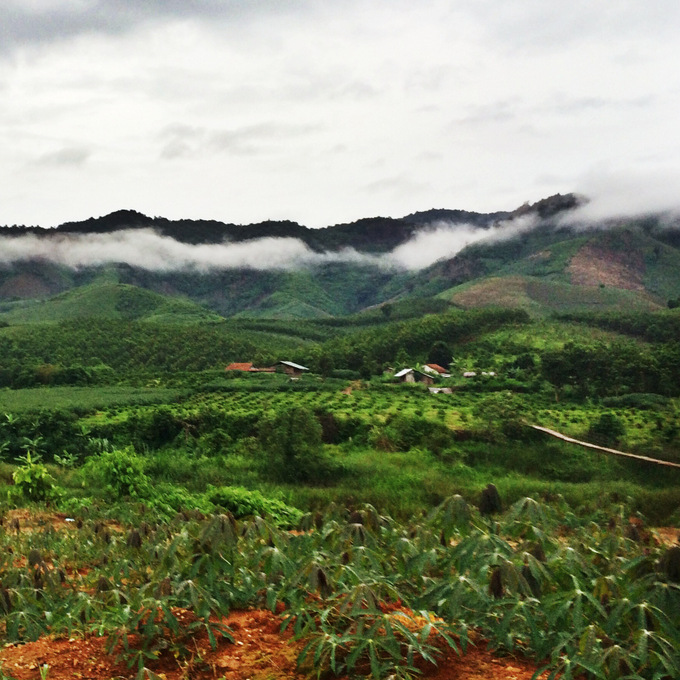
view from the road
That all changed after a month of traveling by bus, train, and plane! We arrived in Hue and were sick of early morning busses, local busses that stop for whatever reason the driver wants {and drive around the city for three hours picking up enough people to make a trip worth their time}. Knowing that we were out of the big cities, and feeling like we had more of a handle of Vietnamese traffic “rules” {HA!}, we took the plunge. We bought our bikes, which are technically scooters {we’re cool like that} in Hue from Kim Thien. We read another travelers experience with him, detailing what an honest and kind guy Kim was, so we went to check him out. Turns out, Kim was really was a great guy! You can find him at 24 Nguyen Sinh Cung Street in Hue. At first weren’t sure if we got a good deal, but after answering numerous curious Vietnamese {wondering how much we paid for our bikes} we were surprised to hear that we actually got a great deal. For the two automatic Yamaha Nuovo scooters, we paid 9,000,000 VND. That’s about $450 USD. You can find much cheaper bikes {manuals, not scooters, etc.}, if you want. We then bought helmets, ponchos, and straps for our luggage. We were off!

Views from the road are amazing!
Motorbiking through Vietnam really was incredible. There were so many times Derek and I would drive next to each other and just grin at each other {until one of us got a bug in our teeth} — it was magical. Driving yourself through the countryside forces you to connect with the land and the people more than you ever would by taking a bus. You will have mechanical difficulties, which require you to talk to the locals, sit in a mechanics shop and “chat” as best you can. It will take you longer to get places, so you’ll need to stop in obscure little towns for lunch, or overnight, and find a place to sleep. You’ll see curious things and people on the backroads, who are so friendly and smile at you all the time. You can stop whenever you feel like it, to chat with the farmers or little kids on the side of the road. You’ll experience the elements {sun, wind, rain} VERY intimately — make sure you plan for all three of those things. It was hard, and tiring, and sometimes scary, but ultimately 100% worth it: I think everyone should motorbike through Vietnam!
These days, it’s easiest to have a smartphone to find your way. Even if you don’t have service {which is super easy to get, so do it if you can}, you should still show up on your maps. You can see where you are, and where you need to go. If you don’t have a smart phone, you’ll want to have a detailed map with you and be ready to ask a lot of locals if you’re going the right way! There are very few signs, so you can’t assume you’re going the right way!
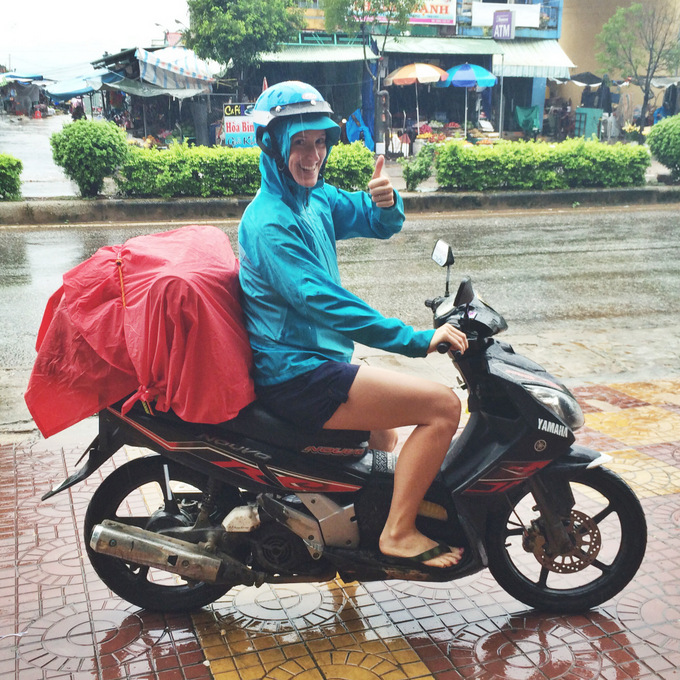
Geared up for a rainy day!
Overall, we drove from Hue to Ho Chi Minh City. The first day was Hue to Hoi An, and was definitely our longest day on the bikes {mostly due to being newbies}. This drive is mostly beautiful, but also has a bit of Highway 1 — which should be avoided at all costs, in my opinion. Highway 1 has the tourist busses and big trucks, which will pass anything and everything at any point in the road. You, being the smallest creature on the road, need to be hyper-aware: they won’t avoid you, you need to avoid them.

Midday stop at Pongour Waterfall, south of Dalat.
Between Hue and Hoi An, you definitely want to take Hai Van Pass. It’s gorgeous, has very little traffic, and avoids the Highway 1 Tunnel. Once you get to Danang, you can either go straight through the city {which we did, at rush hour, which was terrifying but surprisingly manageable}, or hug the coast. I’d suggest hugging the coastline. After having driven that road between Danang and Hoi An a few times, it’s much less busy {and way more beautiful} than going through Danang on Highway 1. The quality of the road on this stretch is really great!
After spending a month in Hoi An, we ventured on! Originally, we wanted to go down the coast. After hearing that Nha Trang was not worth our time, and wanting to avoid Highway 1, we decided to go inland to the Ho Chi Minh Highway. GOOD DECISION. We headed straight West from Hoi An, and after a few slow hours through populated areas we made it to the HCMH. Gorgeous road! We started making much better time (50 km/hr instead of 20 km/hr) once we hit the HCMH. We took things much slower than most travelers, mostly because our booties couldn’t take sitting on our seats for very long at once! We’d pull over for some handstand breaks {much to the amusement of the locals}, coffee, lunch, etc. frequently. It took us five days, two of which were really more like half-days, to get to Dalat from Hoi An. Our stops were: Plei Can, Pleiku, Ea Drang, and Lien Son.
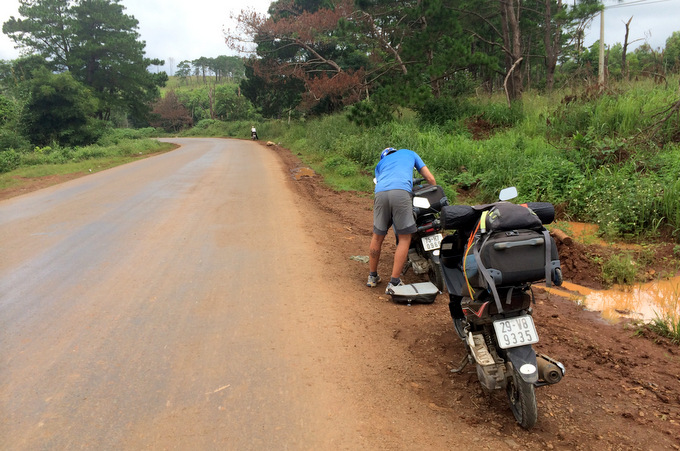
Driving between Hoi An and Pleiku was quick and easy. From Pleiku to Eu Drang was slow and arduous: there was a lot of construction, dirt and gravel sections, and generally slow roads. We were exhausted after driving that section! About halfway between Eu Drang and Buon Ma Thuot, the roads improve and stay generally good {with a few exceptions} all the way to Dalat. After Dalat, we drove to Mui Ne {pretty nice roads/drive}, then Ba Ria, then HCMC. You could do Mui Ne to HCMC easily in one long day, but we wanted to arrive in HCMC midday and avoid traffic, so we opted to add in one more day. Here’s our route, correct except for Hai Van Pass between Hue and Hoi An, where Google wouldn’t insists I went through the tunnel AND over the pass {I didn’t}:
After Dalat, we made our way to HCMC via Mui Ne and Ba Ria. I think this drive could easily be done in two days, but we wanted to make it into HCMC earlier in the day to avoid heavy traffic. I’m glad we did!
You will likely experience a few mechanical difficulties — especially if you have an older bike, like a Honda Win. We were pretty lucky, and only had a few flat tires and one gasline issue. After two flats on my bike, we splurged for a new tire, and then only had one more on Derek’s bike. Luckily, there are mechanics EVERYWHERE! We never had to roll more than 500 feet to a mechanic each time we had a problem. Fixing a flat shouldn’t cost more than 100,000 VND ($5 USD), but they might ask for anything between 70,000 and 150,000. My new tire cost 300,000 VND ($15 USD). For our gasline issue, which took at least one hour to fix {but no new parts}, we paid 70,000 VND.

Typical mechanic shop.
Make sure you fill up with gas regularly… we had a few close calls! Thankfully, many shops on the side of the road sell gas by the liter. When in doubt, fill up! Automatics take more gas than manuals, so just get to know your bike and how accurate the gas gauge is. If you go to a “real” gas station, keep your eye on the numbers on the pump — in touristy areas (particularly, Hoi An), you WILL be ripped off if you aren’t careful. Make sure they set the numbers to zero, and then DO NOT TAKE YOUR EYES OFF THE METER. In Hoi An we had to be really insistent, every time we got gas, and ignore the attendants as they try to distract you from the numbers on the pump. They got really annoyed at us having figured out their game, and then would just try to not give us enough change: try to pay with exact change, and know how big your tank is so you know what you SHOULD be paying.
We didn’t have racks on our bikes, but just attached our bags behind us on the seats. We tried both rope and bungees, and the bungees were by far the better option: they kept our bags stationary, and were easy to get on and off. The rope was a huge pain and required re-adjusting every 30km {or more frequently}.
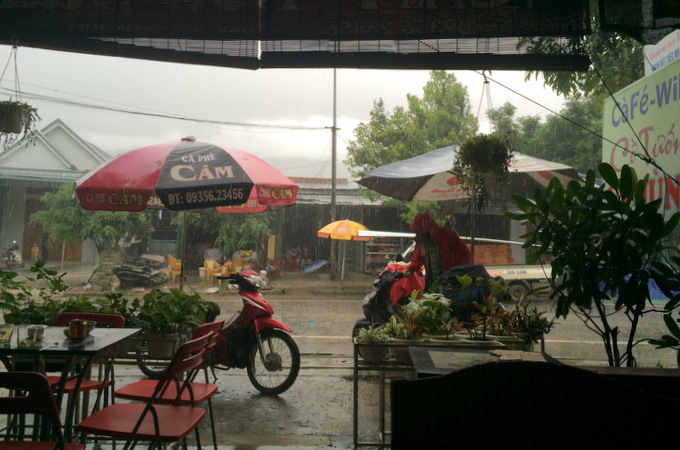
a well-timed coffee break!
As for driving rules in Vietnam, it seems there aren’t many. There is a t-shirt here that says “Green light: I can go. Yellow light: I can go. Red Light: I can STILL go!” It’s very true, especially in the North. The number one thing I keep in mind driving here is simply this: don’t hit anything. It seems silly at first, but the mentality seems to be the opposite of what we’re used to at home (“don’t get hit”). Don’t make sudden, jerky movements. Signal clearly (with your hand, if possible) and insistently. USE YOUR HORN. It’s not rude to honk here — it’s necessary to let people know where you are. If you ever pass someone, or approach an intersection, or go around a blind corner, HONK. A LOT. Mostly, just observe traffic for a bit before trying to drive: you’ll probably get the hang of it. The speed limit isn’t always posted, so I just try to go with the flow of traffic. Right turn on red is illegal, so don’t do it!
Legality of a foreigner driving a moto here is a topic you’ll need to explore and decide about for yourself. Our motto is “don’t break any laws while driving and we’ll be okay” — and it worked for us! Always wear your helmet, don’t hit anyone, don’t speed or drive obnoxiously. I just try to be unassuming and not in the way, as well as confident. There are plenty of police roadblocks set up, but they always waved us through — although I was always terrified we’d get pulled over!
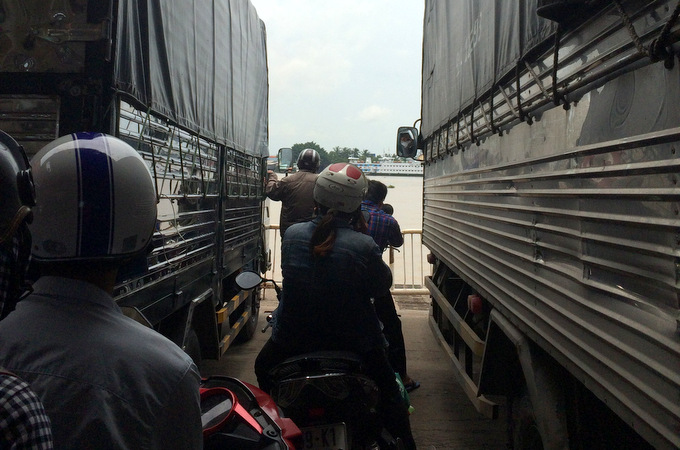
The view on the ferry into HCMC — squeezed between trucks!
Financially, buying a moto was a better deal than taking buses everywhere. When we were in a city, we didn’t have to pay for taxis (which is a HUGE savings), and we saved money between cities by avoiding expensive bus rides. We also had way more freedom to choose our schedule, which was worth a lot to us. As for selling your bike, you should post it on Craigslist a few days before you reach your destination, and perhaps post some flyers in the grungiest backpacker hostels in the area once you get there. You can also go to a local shop, in the touristy areas of Hanoi or HCMC {Do Quang Dau in District 1}, and likely sell your bike to a local who will turn it right around and sell to another tourist. This is easiest, but you’ll probably get less money this way. We sold our bikes this way, and ended up losing about $90 total — which was still better than paying for busses and taxis through the entire country.
If you have any more specific questions about our experience motorbiking through Vietnam, feel free to email me or leave them in the comments!
0
This post is about our encountering motorbiking through Vietnam, composed keeping in mind the desire of helping future motorbikers! We’ve been looking at coming to Vietnam for quite a long time, lastly began making arrangements to do it when we got connected with two and half years prior. At first, we discussed motorbiking all through the whole nation — it appeared like a fun and brave approach to see the area! We let that thought slide, as we conversed with more individuals who let us know we’d be killed inside of two seconds of driving in Hanoi. We touched base in Hanoi and concurred that motorbiking there was most likely an errand we weren’t prepared to handle.